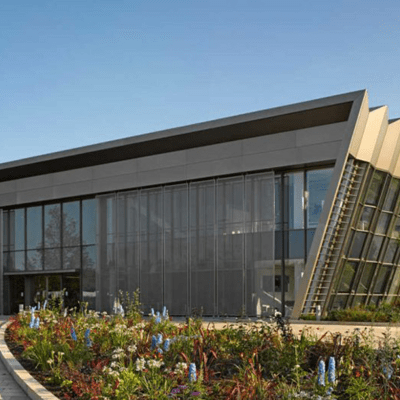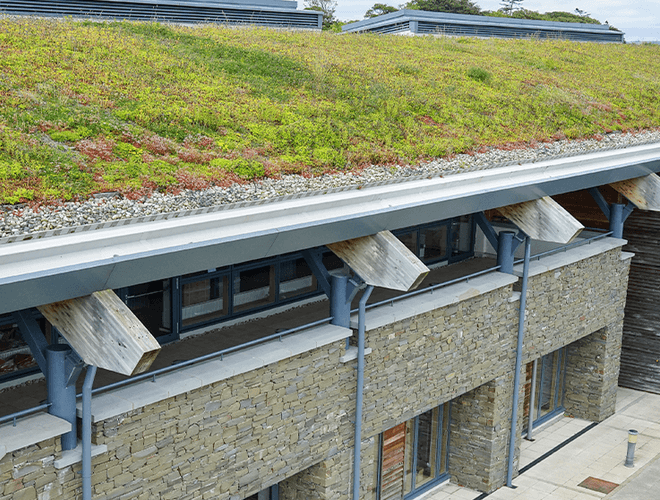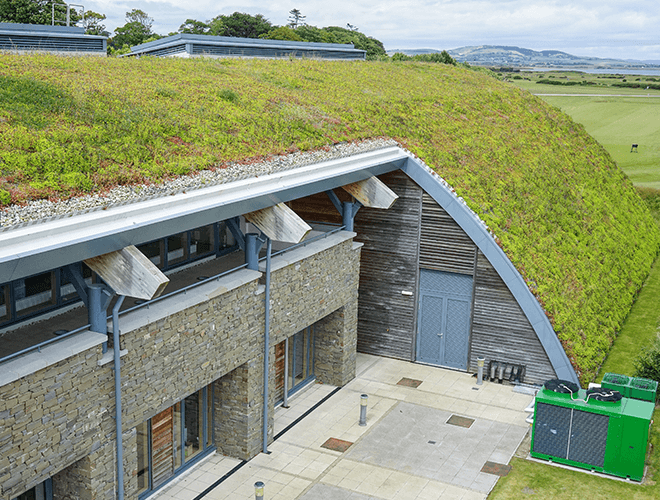
Author
Bailey
Specifying for an eco-friendly building project can be a challenge, especially with so many products and tools used by the construction industry being attributed to a large proportion of the UK's co2 emissions.
So, what simple changes can you implement to reduce your project’s carbon footprint? Here we look at how different options for the building envelope can contribute towards an environmentally friendly project, and help you achieve sought-after accreditations such as BREEAM and the WELL Building Standard.
Consider an eco-roof.
Did you know that the widespread installation of eco-roofing in cities could slow the planet-heating effect of CO2 emissions by up to two years?
Eco-roofing is not only easy to install but can be retrofitted onto an existing roof, making it a cost-effective and sustainable option to consider if you want to reduce your carbon footprint. Installed as either an intensive roof (a recreational garden) or an extensive roof (which provides a natural habitat for wildlife), eco-roofs are both environmentally responsible and beneficial.
Covered in plants that work to reduce CO2 pollution by converting carbon dioxide into oxygen through the process of photosynthesis, eco-roofs generate an improved air quality, as well as encouraging biodiversity by creating a natural habitat for displaced flora and fauna.
Here at Bailey, we offer flexible specifying for both intensive and extensive eco roofing, with pre-grown models available to limit any intensive labour.
Ensure a building is properly insulated.
Establishing suitable insulation is important when it comes to improving a building’s carbon footprint and energy efficiency, without adequate insulation a building’s heat is lost through its walls and roof. This can result in higher levels of energy usage – and the burning of more fossil fuels – to keep buildings warm, producing unnecessary amounts of carbon dioxide that wouldn’t need to occur if proper insulation was installed.
Rainscreen cladding is an effective way to ensure your building is well insulated. Rainscreen cladding is a system designed to work with the elements to protect the structure of a building. It offers insulating properties, whilst also controlling water, wind and fire. On top of this, rainscreen cladding can add aesthetics to your building, with a variety of designs available. At Bailey, we offer rainscreen cladding in a variety of materials and finishes, both through our adaptable standard range and bespoke designs.
Another way to ensure a high level of insulation is to install a coping system. A coping system, which seals joints, has an integral thermal break at the bottom of the coping bracket that prevents cold bridging. Our C-Fix Coping System is compatible with our eaves, rainwater and roofing systems, and works to reduce heat loss through the top of the wall. The environmentally efficient system ensures your project has exceptional weatherproofing capabilities and insulating properties.
Refrain from using flames.
Torch-on application methods for roofing systems can result in the production of carcinogenic fumes, which are not only bad for human health but also the environment. There are other installation options available to contractors, including hot air welding and adhesive methods. These installation methods are more environmentally friendly as they don’t produce harmful gases. On top of this, most torch-on roofing membranes cannot be recycled, whereas systems that use alternative installation methods often can be re-used.
If you are looking for an efficient alternative to traditional torch-on systems, look no further than the Bailey System 5000, a single layer, flame-free felt roofing system. Manufactured with an untearable spunbond polyester carrier and coated with an SBS (styrene butyl styrene) modified bitumen, System 5000 is a high performing and efficient alternative to traditional single-ply systems.
Think about water consumption.
Thinking about how a building is going to receive, treat and use its water can majorly impact on its carbon footprint. Specifying products such as toilets with reduced average flush volumes can increase a building’s energy efficiency in the same way as harvesting any runoff rainwater from your roof. Some roofing materials contaminate water, but others, such as an eco-roof or the Bailey Atlantic system, collect water that is free of chlorides, fluorides and plasticisers so won’t result in a contaminated water system. Eco-roofs can also retain up to 90% of the rainwater they receive, reducing flood risks.
Specifying an eco-roof, or a lighter coloured roof such as a white roof could lower water consumption by as much as 9% if implemented universally. This is because eco and lighter coloured flat roofs make surfaces cooler by absorbing heat and evaporating water, cooling and humidifying the air in the microclimate. This, in turn, impacts on any surrounding landscape, as when it is cooler plants and shrubs need less water.
Use recyclable, sustainable materials.
Using a secondary resource, for example, recycled aluminium can produce up to 95% less CO2 emissions than using the raw material for the first time. Many of our soffit, eaves and façade systems are manufactured from aluminium which is almost infinitely recyclable and is considered amongst the most sustainable of the world’s resources. If building constructors used recyclable, sustainable materials instead of single-use materials we could see a significant decrease in the industry’s carbon footprint.
Created from sustainable TPE (thermoplastic polyethene), the Bailey Atlantic flat roofing system is 100% recyclable. It contains no chlorides, fluorides or plasticisers, produces no carcinogenic fumes during its flame-free installation and Bailey Atlantic can be melted down and recycled again and again. The single-ply roofing membrane is one of the highest-performing environmentally beneficial waterproofing membranes on the market.
Take responsibility.
Here at Bailey, we strive to be able to offer the most sustainable building envelope solutions on the market. We all have a responsibility to reduce the impact the construction industry is having on the planet – let’s work together to specify an environmentally friendly envelope solution for your next building project.
Related Work & Articles




